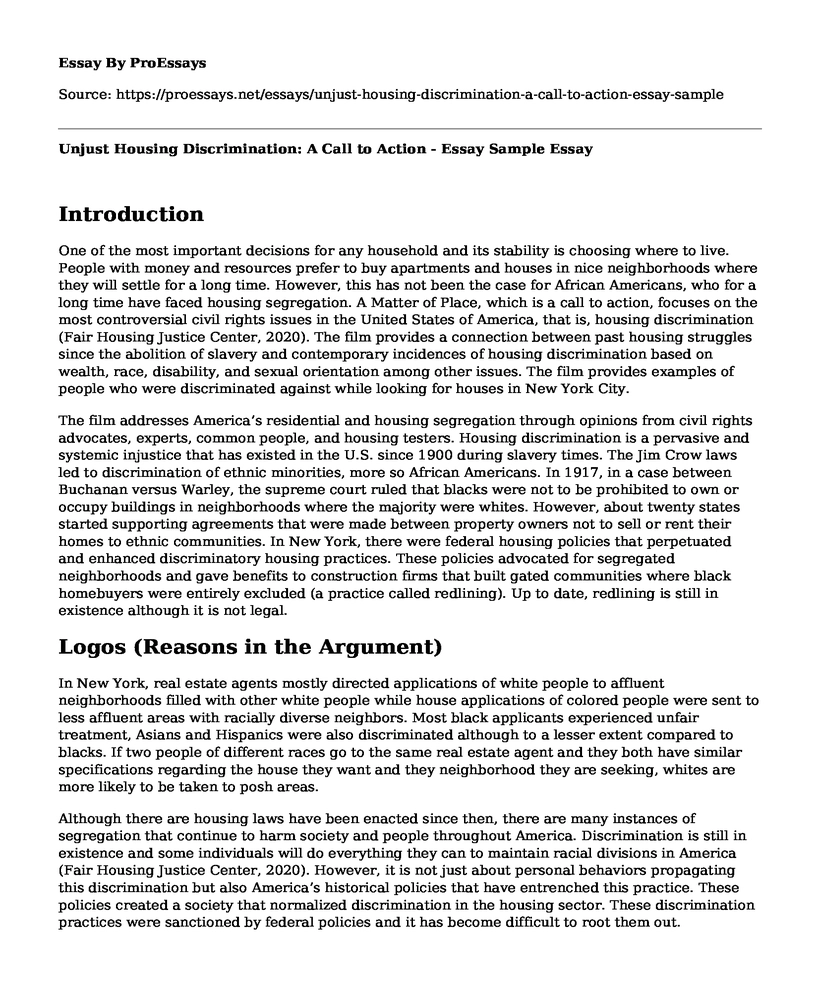Introduction
One of the most important decisions for any household and its stability is choosing where to live. People with money and resources prefer to buy apartments and houses in nice neighborhoods where they will settle for a long time. However, this has not been the case for African Americans, who for a long time have faced housing segregation. A Matter of Place, which is a call to action, focuses on the most controversial civil rights issues in the United States of America, that is, housing discrimination (Fair Housing Justice Center, 2020). The film provides a connection between past housing struggles since the abolition of slavery and contemporary incidences of housing discrimination based on wealth, race, disability, and sexual orientation among other issues. The film provides examples of people who were discriminated against while looking for houses in New York City.
The film addresses America’s residential and housing segregation through opinions from civil rights advocates, experts, common people, and housing testers. Housing discrimination is a pervasive and systemic injustice that has existed in the U.S. since 1900 during slavery times. The Jim Crow laws led to discrimination of ethnic minorities, more so African Americans. In 1917, in a case between Buchanan versus Warley, the supreme court ruled that blacks were not to be prohibited to own or occupy buildings in neighborhoods where the majority were whites. However, about twenty states started supporting agreements that were made between property owners not to sell or rent their homes to ethnic communities. In New York, there were federal housing policies that perpetuated and enhanced discriminatory housing practices. These policies advocated for segregated neighborhoods and gave benefits to construction firms that built gated communities where black homebuyers were entirely excluded (a practice called redlining). Up to date, redlining is still in existence although it is not legal.
Logos (Reasons in the Argument)
In New York, real estate agents mostly directed applications of white people to affluent neighborhoods filled with other white people while house applications of colored people were sent to less affluent areas with racially diverse neighbors. Most black applicants experienced unfair treatment, Asians and Hispanics were also discriminated although to a lesser extent compared to blacks. If two people of different races go to the same real estate agent and they both have similar specifications regarding the house they want and they neighborhood they are seeking, whites are more likely to be taken to posh areas.
Although there are housing laws have been enacted since then, there are many instances of segregation that continue to harm society and people throughout America. Discrimination is still in existence and some individuals will do everything they can to maintain racial divisions in America (Fair Housing Justice Center, 2020). However, it is not just about personal behaviors propagating this discrimination but also America’s historical policies that have entrenched this practice. These policies created a society that normalized discrimination in the housing sector. These discrimination practices were sanctioned by federal policies and it has become difficult to root them out.
Pathos (Emotional Content)
Several laws have been enacted to fix past mistakes. In 1968, the Fair Housing Act was enacted making housing discrimination illegal. It is therefore wrong for real estate agents to show any discrimination (by either refusing to sell a home or taking people to different places because of their races). However, inequalities persist due to a racialized injustice system. Segregated neighborhoods have increased racial inequalities because these neighborhoods are not only divided by race but also access to crucial resources and amenities such as Wi-Fi, safe and secure communities, and shops selling healthy and fresh foods among others. Housing discrimination enhances the racial wealth gap that has made it difficult for Black Americans to have a good life. It perpetuates the generational wealth division and upholds the white supremacy concept.
The discrimination portrayed in the film is not surprising at all because black Americans have always been excluded and denied opportunities that provide upward mobility and economic security. There is a need to eliminate all instances of housing discrimination, enhance integration, and create equal opportunities for everyone. The film tries to educate people on their housing rights and educating them with the necessary tools required to enforce these rights.
References
Fair Housing Justice Center (2020). A Matter of Place. Accessed online https://www.fairhousingjustice.org/resources/film/
Cite this page
Unjust Housing Discrimination: A Call to Action - Essay Sample. (2023, Aug 02). Retrieved from https://proessays.net/essays/unjust-housing-discrimination-a-call-to-action-essay-sample
If you are the original author of this essay and no longer wish to have it published on the ProEssays website, please click below to request its removal:
- Essay Example: Women Rights in the Play A Doll's House
- Violence Against Women and Girls - Sociology Essay Example
- What Can School Staff Do to Prevent Bullying? - Essay Sample
- Cellphone Usage and Attention While Driving Essay
- Video Analysis Essay on Race Discrimination
- The Lowering of Confederate Symbols: Rejecting Hate & Discrimination - Essay Sample
- Audism: Discrimination Against Hearing-Impaired People - Essay Sample







